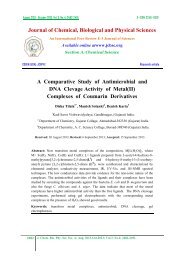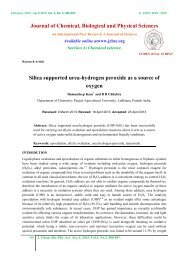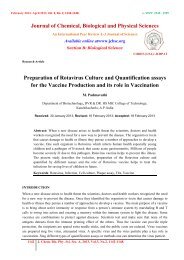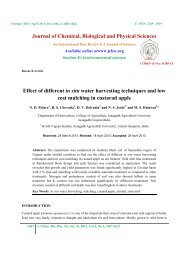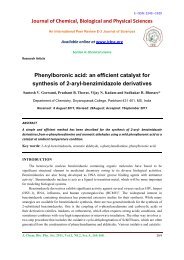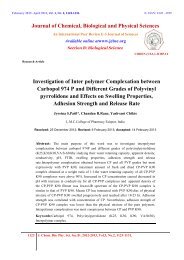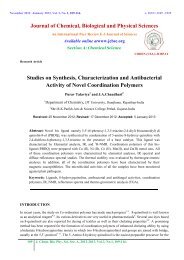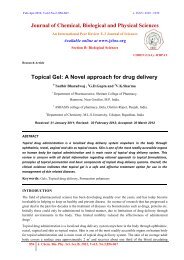Studies on Antimicrobial Properties of Vegetable, Fruit & Spice ...
Studies on Antimicrobial Properties of Vegetable, Fruit & Spice ...
Studies on Antimicrobial Properties of Vegetable, Fruit & Spice ...
- No tags were found...
Create successful ePaper yourself
Turn your PDF publications into a flip-book with our unique Google optimized e-Paper software.
<str<strong>on</strong>g>Studies</str<strong>on</strong>g> <strong>on</strong>….Suvro Saha et.al.pieces. In case <strong>of</strong> coc<strong>on</strong>ut and st<strong>on</strong>e apple the shells were neatly shaven. Then these peels and shellswere set aside for drying in sunlight for 24 hours and shifted to an hot air oven at 40 0 CMicrobial Strains & Culture Preparati<strong>on</strong>:Bacterial Strains used: Staphylococcus aureus, Proteus vulgaris, Lactococcus lactis, Bacillussubtilis, Escherichia coli, Klebsiella pneum<strong>on</strong>ia.Fungal strains used: Sporotrichum pruinosum, Candida albicans and Aspergillus niger.The bacterial cultures were maintained <strong>on</strong> nutrient agar media (pH-7.0). They were sub-culturedweekly and subsequently stored at 4 0 C. The fungal cultures were maintained <strong>on</strong> Czapek Dox Agarmedia (pH-5.6) and they were sub-cultured weekly and subsequently stored at 4 0 C for another 24hours. After complete drying, peels and shells were subjected to homogenizati<strong>on</strong> to make finepowder. These powders were sealed in air tight bottles. They were then used for solvent extracti<strong>on</strong>.Extracti<strong>on</strong> Procedure: The dried powder <strong>of</strong> peels and shells were extracted individually by usingsolvents such as Acet<strong>on</strong>e, Methanol, Hot water & Cold Water. The powder and solvent were mixed in1:10 (Powder: Solvent) ratio in a c<strong>on</strong>ical flask and the flasks were plugged tightly. The temperaturefor the hot water extracti<strong>on</strong> and cold water extracti<strong>on</strong> were maintained at 50 0 C and room temperaturerespectively. After 24 hours, these extracts were centrifuged at 4000rpm for 5 minutes and thesupernatant was collected and this supernatant was subjected for lyophilizati<strong>on</strong> to evaporate thesolvent. Then the resulting dried crude extract was used in a c<strong>on</strong>centrati<strong>on</strong> <strong>of</strong> 3mg/ml by using sterilewater for antimicrobial susceptibility testing.Bacterial and Fungal Strains & Culture Preparati<strong>on</strong>: The bacterial strains used in the study wereStaphylococcus aureus, Proteus vulgaris, Lactococcus lactis, Bacillus subtilis, Escherichia coli,Klebsiella pneum<strong>on</strong>ia. The fungal strains were Sporotrichum pruinosum, Candida albicans andAspergillus niger.The bacterial cultures were maintained <strong>on</strong> nutrient agar media (pH7.0). They were sub-culturedweekly and subsequently stored at 4 0 C. The fungal cultures were preserved <strong>on</strong> Czapek Dox Agarmedia (pH 5.6) and were sub-cultured weekly and subsequently stored at 4 0 CANTIMICROBIAL ACTIVITY ASSAYThe antimicrobial activity <strong>of</strong> the obtained crude samples was performed by Agar Well Diffusi<strong>on</strong>method which is also known as Kirby Bauer or Cup Plate method.Antibacterial Activity: Sterile nutrient agar media was poured <strong>on</strong>to the sterile petriplates and allowedto solidify. After solidificati<strong>on</strong> 20µl <strong>of</strong> each bacterial culture was spread with a sterile glass spreader<strong>on</strong> respective plate labeled earlier as Staphylococcus aureus, Proteus vulgaris, Lactococcus lactis,Bacillus subtilis, Escherichia coli, Klebsiella pneum<strong>on</strong>ia. Using a sterile cup-borer, wells <strong>of</strong> diameter<strong>of</strong> 17.78mm were made and labeled <strong>on</strong> the back <strong>of</strong> the plate. To this, 20µl <strong>of</strong> each samples (3mg/ml)was dispensed in respective labeled wells. Bacterial plates were incubated at 37 0 C for 24hours. Afterthis the antibacterial activity <strong>of</strong> each extract was expressed in terms <strong>of</strong> mean <strong>of</strong> diameter, for the z<strong>on</strong>e<strong>of</strong> inhibiti<strong>on</strong> (mm) formed by additi<strong>on</strong> <strong>of</strong> each extract.Antifungal Activity: Sterile Czapek Dox Agar media was transferred <strong>on</strong>to the sterile petri plates andallowed to solidify. After solidificati<strong>on</strong>, with a sterile glass spreader, 20µl <strong>of</strong> each fungal culture wasspread <strong>on</strong> respective plate labeled earlier as Sporotrichum pruinosum, Candida albicans andAspergillus niger. using a sterile cup-borer, wells <strong>of</strong> diameter <strong>of</strong> 17.78mm were prepared and labeledat the flipside <strong>of</strong> the plate. 20µl <strong>of</strong> each sample (3mg/ml) was dispensed in respective labeled wells.1888 J. Chem. Bio. Phy. Sci. Sec. B; 2013, Vol.3, No.3; 1886-1899.



